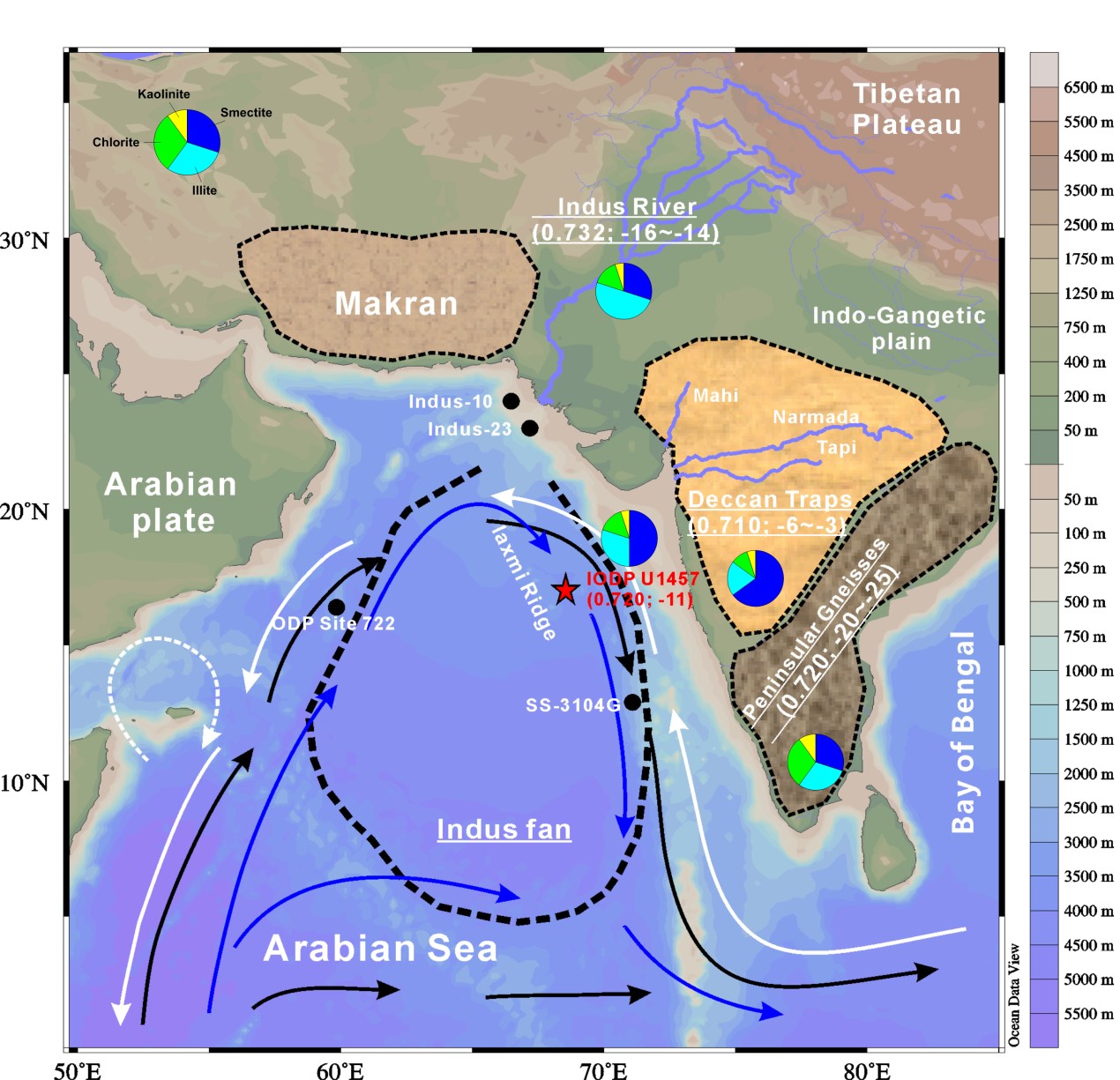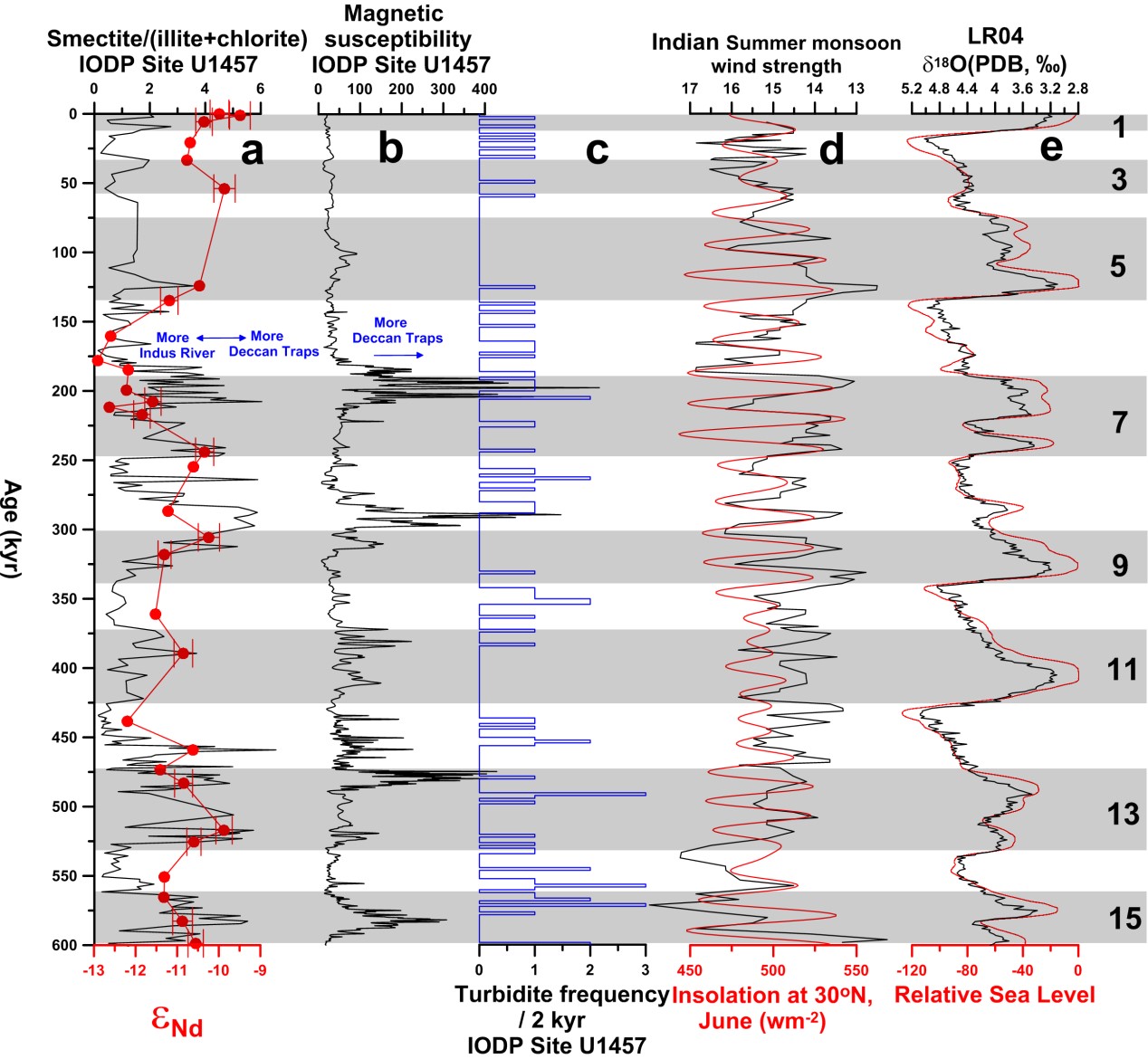Recently, the Journal “Quaternary Science Reviews” publishes new results of International Ocean Discovery Program (IODP) Expedition 355 from cooperative studies of vice prof. Zhaojie Yu with colleagues from USA, France, Germany and India titled “Sea level-controlled sediment transport to the eastern Arabian Sea over the past 600 kyr: Clay minerals and Sr-Nd isotopic evidence from IODP site U1457”.The 3 studies from IODP Expedition 355 indicates a dominant influence of sea-level variations on sediment trans.
The IODP is one of the most influential marine research collaboration program that explores Earth's history and dynamics using ocean-going research platforms to recover data recorded in seafloor sediments and rocks and to monitor sub-seafloor environments. The IODP Expedition 355 (Arabian Sea Monsoon) started in Colombo, Sri Lanka from 31 March to 30 May, 2015, aiming to better understand the co-evolution of Tibetan plateau uplift, Indian summer monsoon evolution, weathering and erosion of Himalaya through multiple time scales.
Long term marine sediment archives deposited in the deep-sea fan are key materials to study the sensitivity of sediment dynamics in responding to monsoon precipitation evolution and sea-level variations. Previous studies suggest that both Indian summer monsoon precipitation and sea-level are playing important roles in determining the sediment transportation from the large river basin to the deep-sea fan in the Asia area. On the orbital times cale, both the spectra of East Asian summer monsoon and sea level proxies indicate dominant 100-kyr eccentricity bands during the Late Quaternary in the East Asia marginal seas (such as the South China Sea), making it difficult to decipher the different influence of these two processes on the sediment transportation. However, this is not the case in the South Asia are. In the Arabian Sea, the Indian summer monsoon precipitation is mainly forced by the 23-kyr precession cycles, while the sea-level is conservative at 100-kyr eccentricity cycles. Therefore, it is possible to use this different dominant orbital cycles to estimate the different influence of Indian summer monsoon precipitation and sea-level on sediment transportation in the Arabian Sea.
Dr. Zhaojie Yu from Institute of oceanology, Chinese Academy of Sciences, invokes clay mineralogy, detrital grain-size and Sr-Nd isotopic compositions analysis on sediments from the Laxmi basin, eastern Arabian Sea in order to reconstruct a high-resolution orbital sediment export record to the Indus deep-sea fan and estimate the relative importance of Indian summer monsoon precipitation and sea-level. The sediment sources during glacial-interglacial cycles as well as position and width of turbidite layers are carefully identified and a high-resolution of smectite/(illite+chlorite) record indicating a balance of sediments inputs from Indus River and Deccan Traps to IODP Site U1457 is established.
The results indicate that more turbidite deposits are accompanied by Indus River sediments during glacial sea-level lowstands, while conversely, more hemipelagic deposits are associated with Deccan Traps sediments during interglacial sea-level highstands. The wavelet and cross-spectral analyses of smectite/(illite+chlorite) record versus sea-level and Indian summer monsoon suggest a strong mechanistic link between the sea-level variations and sediment transportation from the large river basin to the deep-sea fan, while the influence of monsoon precipitation is subordinate. Such results shed light on the dominant role of sea-level variations in comparing to the summer monsoon precipitation in deterring the sediment transportation from a source-to-sink perspective.
The study was supported by IODP France and National Natural Science Foundation of China.

Figure 1 Bathymetric map showing the location of IODP Site U1457 as well as the nearby geologic structures (Arabian plate, Makran, Indo-Gangetic plain, Deccan Traps and Peninsular Gneisses) and marine sediment cores noted in this paper.

Figure 2 Comparison of a) smectite/(illite t chlorite) ratio (black line) and εNd (red line) from IODP Site U1457 (this study); b) magnetic susceptibility variation from IODP Site U1457 (Pandey et al., 2015); c) turbidite frequency in core from IODP Site U1457 (this study); d) Indian summer monsoon wind strength reconstructed from lithogenic grain size of ODP Site 722 (Clemens et al., 1996) and insolation at 30°N in June (Laskar et al., 2004); e) stacked global benthic d18O record of LR04 (Lisiecki and Raymo, 2005) and global sea-level variation (Bintanja et al., 2005).

Figure 3 Wavelet power analysis for a) smectite/(illite + chlorite) ratio from IODP Site U1457 (this study); b) global sea-level variation (Bintanja et al., 2005); c) Indian summer monsoon wind strength reconstructed from lithogenic grain size of ODP Site 722 (Clemens et al., 1996).
Reference paper mentioned:
1. Yu, Zhaojie., Colin, C., Wan, S., Saraswat, R., Song, L., Xu, Z., Clift, P., Lu, H., Lyle, M., Kulhanek, D., Hahn, A., Tiwari, M., Mishra, R., Miska, S., Kumar, A., 2019. Sea level-controlled sediment transport to the eastern Arabian Sea over the past 600 kyr: Clay minerals and Sr-Nd isotopic evidence from IODP site U1457. Quaternary Science Reviews 205, 22-34.
Link:https://www.sciencedirect.com/science/article/pii/S0277379118305663
|
|

Address: 7 Nanhai Road, Qingdao, Shandong 266071, China
Tel: 86-532-82898902 Fax: 86-532-82898612 E-mail: iocas@qdio.ac.cn


